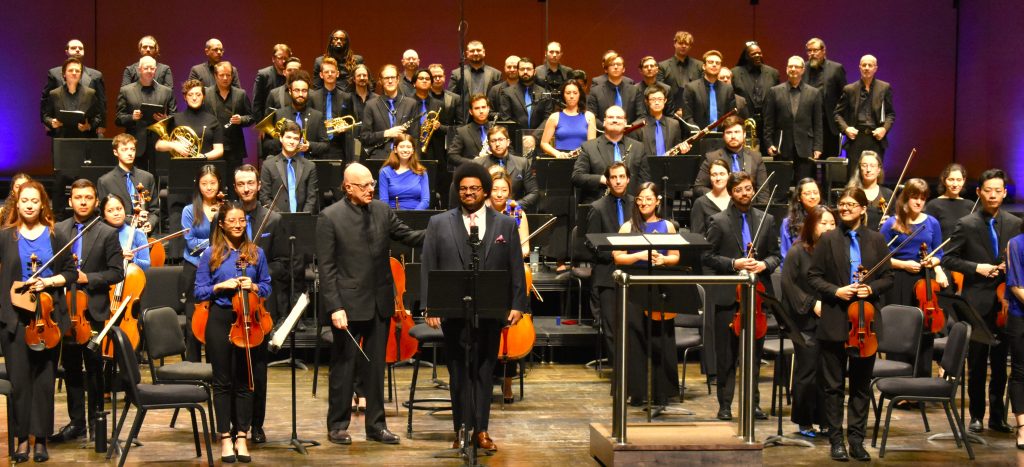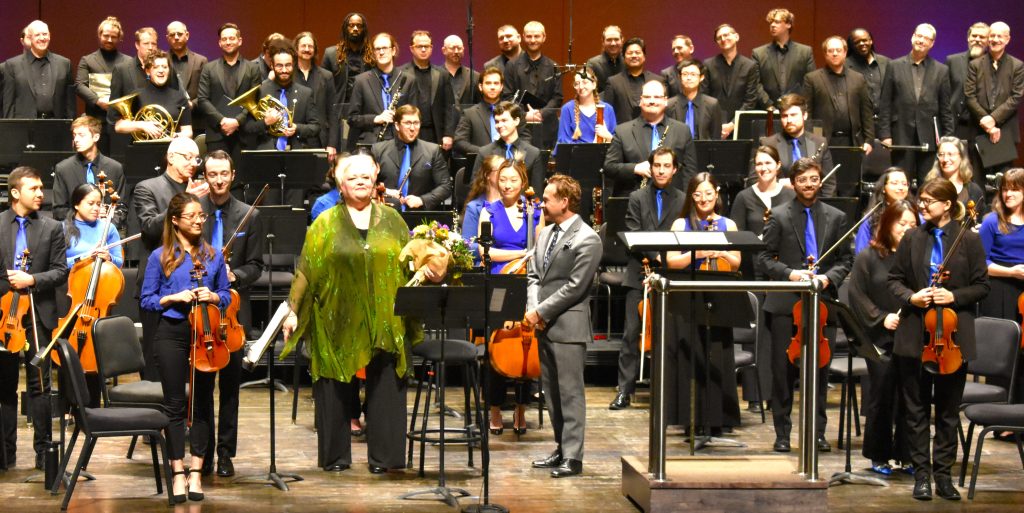
by Kevin T McEneaney
This well-attended All-Brahms concert last weekend offered a combo of songs and music: the first half concentrating on vocal music, the second half featuring orchestral music, his first symphony.
They opened with Rinaldo, a tenor cantata with four-part male chorus. The work (about 80% of it) from 1863 was not finished that year and shelved; it was premiered in Vienna, February 28, 1869. The cantata text is from a Goethe poem translation of an excerpt from Torquato Tasso’s epic Jerusalem Liberated (1581), an epic about the first crusade. This cantata has never been popular (I confess that I am not a Tasso fan—I remain a fan of Ariosto), yet this cantata remains a showcase for a good tenor, and in this case, there was a superb tenor, Joshua Blue who sang with clear diction, impressive phrase delivery, and forceful projection. Blue will be performing in the next forthcoming MET opera production of Mozart’s The Magic Flute.

Bard College super-star Stephanie Blythe held forth with power and subtle nuance in Brahms’ Alto-Rhapsody, a fragment from another Goethe poem: a prayer for peace amid the devastation of despair, an articulation of the deep wound that Clara Schumann would never marry him. As such, it is a peculiarly tormented, emotional masterpiece. Clara was deeply shaken by the work, as anyone who carefully listens to the music might also be amazed: from the opening tremolo strings that lead to an emotional wasteland and situates the artist in that emotional wasteland with nothing but the consolation that art still retains the ability to articulate art in a solitary wasteland far from a life of intimacy. The work contains a plea to God to transform the wasteland to a thousand springs, yet it remains unclear if Brahms is even a minimalist Deist. (Most musicians are devoted to creating music rather than impractical abstractions.) Stephanie Blythe eloquently articulated the heartfelt wound.

The behind-the-scenes choral performance for these two choral works performed was directed with extraordinary clarity, pacing, devotion by James Bagwell who remained off-stage. The unity of the chorus supporting the music delivered a soulful, meditative, ethereal aesthetic.
The TŌN orchestra next performed Symphony no.1 in C minor by Johannes Brahms. After the 1876 premiere of the symphony (which he worked on for twenty-one years), Hans von Bülow quipped that it was the Tenth Symphony (of Beethoven); this perspective derived from the obvious influence of Beethoven’s Ninth Symphony, especially the monumental conclusion of the third moment. Wagner, of course, hated it because the work vigorously championed a tradition which Wagner had declared dead.
Nonetheless, Brahms’ first symphony remains an important work, even though his latter symphonies overshadow the first. Describing the arc of the work as a meditation on fate, Brahms hinted that the work had an autobiographical structure going from his birth to his current achievement as an artist.
I was especially thrilled by the opening, arresting timpani by Pe Hsien Lu which plunges us into the mysterious and dark world of childhood ignorance, and later a sensitive, sensuous, and sumptuous elegance at the conclusion of the first movement, which sounded more soulfully French than Germanic. The Orchestra Now has long been noted for excellent flute players; in the second movement the flute of Olivia Chaikin provided uplifting eloquence that offered a striking dialectic.
The thunderous Beethoven-like conclusion (which recalls the symphony’s opening movement) was rendered with masterful unity under the baton of Dr. Leon Botstein. This finale was most impressive and marvelous, even though it exhibited a slight smidgen of vanity in announcing that Brahms was indeed a second, tormented Beethoven.
